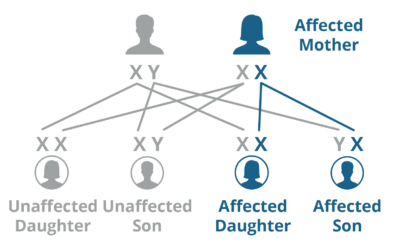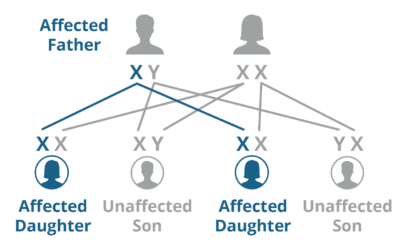WHAT IS FABRY
Gradually, this leads to a range of physical symptoms and complications, which vary from one person to another.
Symptoms in Fabry
Day to day symptoms in Fabry are known to vary from one person to another.

Inheritance
As Fabry disease is an X-linked disorder it can be passed to children by either parent


Testing and Diagnosis
An early diagnosis of Fabry disease is useful for many reasons, including starting symptom management, reducing the risk of further problems happening as well as early identification of other family members who may be affected. Initially, a combination of the signs and symptoms may lead your doctor to think you may have Fabry disease. Your doctor may then refer you to a specialist centre for a diagnosis of Fabry disease to be confirmed and for any treatment to be initiated. Anyone who is thought to have Fabry disease can have the diagnosis confirmed through laboratory testing. This test, called an enzyme assay, measures the amount of alpha-GAL enzyme activity in the blood. In males this can be done by taking a blood sample which is then tested to check the level of the a-Gal A enzyme. If the level of the enzyme is very low a diagnosis of Fabry disease can be made. This test can also be used to confirm the diagnosis of Fabry disease in females, although a laboratory genetic test in which DNA is analysed is a more effective test for confirming the diagnosis in women especially where there is a family history of Fabry disease.
Prenatal diagnosis is possible by measuring the a-Gal A activity in tissue or fluid taken from around the foetus. This test may be offered to expectant mothers who have Fabry disease. Specialist support and advice are available for such testing. An examination of your family history may indicate the presence of Fabry disease, particularly if a male relative suffered from kidney failure, heart disease or stroke early in life. To help identify whether there is the possibility of you or any of your relatives having Fabry disease, you can complete a medical family tree.
Misdiagnosis is common in Fabry disease due to its rarity. Fabry disease has been mistaken for;
Treatment
There is no cure for Fabry disease but current treatments may prevent organ damage and greatly improve the quality of life of patients.
Living with difficult physical symptoms is only one of the challenges people with Fabry disease may face. Fabry disease is a rare disease and you may experience feelings of fear, depression, isolation or guilt about passing the disease along. Family members may be affected as well.
Remember that you are not alone.
We give support to newly diagnosed Fabry patients as well as those with a long history of living with the disease. You may find it helpful to talk with someone else from the Fabry International Network – someone in a similar situation with similar concerns and fears.

